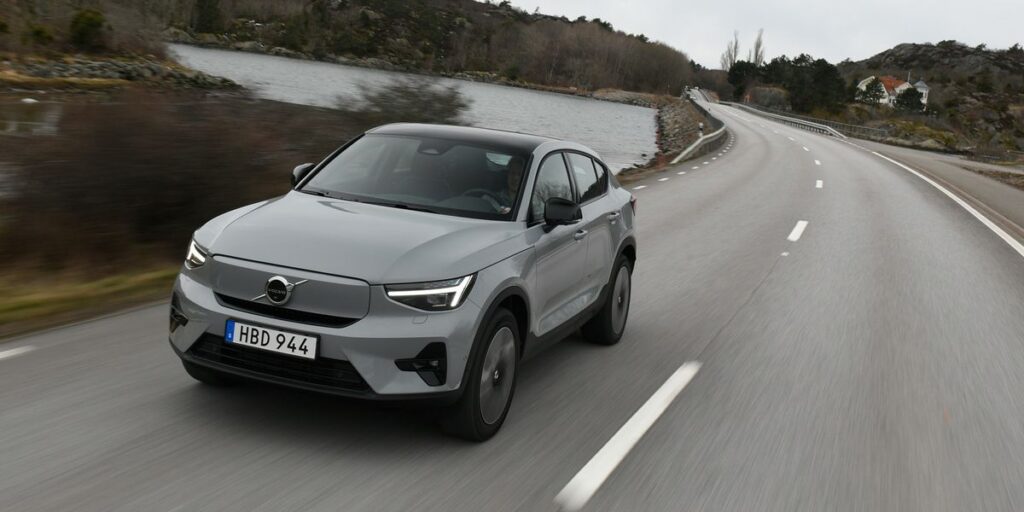2024 Volvo C40 Recharge RWD Is Less Powerful, More Sensible

Volvo is heading to a fully electric future, but the company’s new single-motor EV powertrain shares an obvious link with the brand’s past. This is set to be the first rear-wheel-drive Volvo since the venerable 900 series retired in 1998.
In engineering terms, the choice of a powered rear axle is not a surprise. In EVs as in combustion cars, it makes more sense to split the duties of steering and propulsion. Yet Volvo has reached this rational conclusion in a roundabout way, having previously offered both the C40 Recharge and XC40 Recharge with a single front-mounted motor in Europe. The arrival of a brawnier new motor now sees this configuration reversed, and even though the C40 and XC40 still sit on the same CMA platform as before, they’ve been turned from pullers to pushers.
In the U.S. we never got the single-motor Volvo EVs, so all will be fresh to American buyers when the cars arrive in the second half of the year.
Volvo has designed and engineered the new motor and will build it in Sweden. The same unit will also power the front wheels of the upcoming EX90 SUV, and it is used in the all-wheel-drive XC40 Recharge as well. With just one motor, the rear-drive C40 is obviously less potent than its dual-motor all-wheel-drive counterpart, but output figures of 248 horsepower and 310 pound-feet of torque are still competitive.
We expect the rear-drive C40 to sprint to 60 mph in the mid-six-second range, and our drive in Sweden proved that this Volvo feels plenty rapid. Acceleration off the line is keen, with the continuous flow of power making the C40 feel punchier than its power-to-weight ratio would suggest. (Volvo says the single-motor C40 is 216 pounds lighter than the two-motor version, which would put it at a porky 4550 pounds based on our last test of the latter.)
At higher speeds, the C40’s acceleration becomes progressively less energetic, and our sample car lost much of its mojo by 80 mph. It would take both a long straight and a determined throttle stomping to get it to the 112-mph limiter that Volvo now fits to all its cars. As in the all-wheel-drive XC40, cruising refinement is excellent at highway speeds, and Volvo sensibly hasn’t given the C40 an artificial soundtrack beyond a low-speed warning noise. Near-silence suits it well.
The switch to the new motor has mostly been done to boost efficiency, and here the rear-drive powertrain excels. The rear-drive version gets a new 79.0-kWh battery pack, while the dual-motor C40 sticks with the old 75.0-kWh unit. This is expected to deliver an EPA range of 297 miles (versus 293 miles in the case of the slightly less aerodynamic XC40 single-motor). The 79.0-kWh battery is also capable of accepting peak DC charging speeds of up to 200 kilowatts should you be lucky enough to find such a potent charger, up from the 150-kW peak of the smaller pack.
Although Volvo was eager to highlight the dynamic benefits of rear-wheel drive, the C40’s chassis is still tuned for comfort and stability rather than any high level of athleticism. The car steers accurately, but little meaningful sensation gets through the electric assistance of the power steering, and on standard all-season tires the front wheels washed out under even modest levels of provocation. The stability- and traction-control systems maintain order but can’t be switched to a more permissive sport mode. We suspect that few buyers of the C40 and XC40 Recharge RWD will know or indeed care which axle is powered.
As before, the rest of the C40 continues to make a persuasive case to choose the XC40. The C40’s lower roofline makes it look marginally sleeker, although we defy anybody to actually confuse this four-door crossover with an actual coupe. But it also sacrifices the XC’s impressively spacious rear cabin and dramatically reduces rearward visibility through the heavily raked rear window. It feels like the answer to a question few people are asking, especially as the more practical XC40 should be marginally cheaper. The Google UI system has also managed to pass straight from feeling underdeveloped when it was new to old-fashioned now, many functions having to be mined from submenus.
Despite all that, the C40 Recharge still possesses a strong likability. Given the limited dynamism of the platform, the single-motor version suits the car’s laidback demeanor better than the pricier and heavier all-wheel-drive model.
Arrow pointing downArrow pointing down
Specifications
Specifications
2024 Volvo C40 Recharge
Vehicle Type: rear- or front- and rear-motor, rear- or all-wheel-drive, 5-passenger, 4-door hatchback
PRICE (C/D EST)
Base: $50,000; AWD, $55,000
POWERTRAINS
Motors: permanent-magnet AC, 248 hp, 310 lb-ft or induction AC, 147 hp and permanent-magnet AC, 255 hp (combined output: 402 hp, 494 lb-ft)
Battery Pack: liquid-cooled lithium-ion, 75.0 or 79.0 kWh
Onboard Charger: 11.0 kW
Peak DC Fast-Charge Rate: 150 or 200 kW
Transmissions, F/R: direct-drive
DIMENSIONS
Wheelbase: 106.4 in
Length: 174.8 in
Width: 73.7 in
Height: 62.6 in
Passenger Volume, F/R: 53–55/43 ft3
Cargo Volume, Behind F/R: 49/17 ft3
Curb Weight (C/D est): 4600–4800 lb
PERFORMANCE (C/D EST)
60 mph: 4.3–6.6 sec
100 mph: 10.9–13.2 sec
1/4-Mile: 12.8–15.1 sec
Top Speed: 112 mph
EPA FUEL ECONOMY (MFR’S EST)
Combined/City/Highway: 99–107/106–118/91–96 MPGe
Range: 257–297 mi
Car and driverCar and driver Lettermark logo
European Editor
Mike Duff has been writing about the auto industry for two decades and calls the UK home, although he normally lives life on the road. He loves old cars and adventure in unlikely places, with career highlights including driving to Chernobyl in a Lada.



